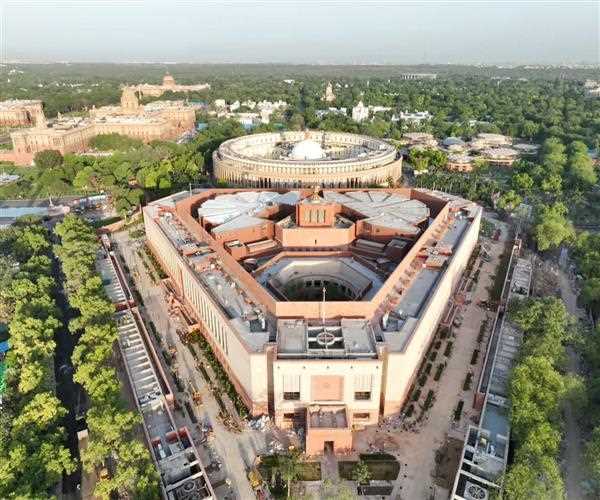
10-Jun-2023 , Updated on 6/12/2023 6:14:07 AM
History of “Sengol” situated in the New Parliament of India
The New Parliament of India, an architectural marvel that stands as a symbol of India's democracy, is home to various historical artifacts and artworks. Among these treasures is the magnificent sculpture called "Sengol," which holds a significant place within the hallowed halls of the new Parliament building.
Let's explore the rich history and cultural significance of "Sengol" and its enduring presence in the heart of India's political landscape.
The Origin of Sengol
Sengol, also known as the "Victory Chariot," is a monumental sculpture created by the renowned Indian artist, Shri Ram Sutar. The idea behind Sengol originated from ancient Indian traditions, where chariots symbolized power, victory, and grandeur. Sutar's artistic vision captured the essence of this concept and transformed it into an awe-inspiring piece of art.
Design and Symbolism
The design of Sengol is an amalgamation of traditional and contemporary elements. The sculpture features a majestic chariot, crafted with intricate details and adorned with symbolic elements. The chariot is pulled by four resplendent horses, representing energy, power, and progress. Each horse symbolizes one of the four cardinal directions, signifying the unity and diversity of India.
At the helm of the chariot stands the mythical bird Garuda, a revered figure in Hindu mythology and the mount of Lord Vishnu. Garuda represents wisdom, courage, and protection, adding a touch of divinity to the sculpture. The entire ensemble rests on a sturdy pedestal, signifying the solid foundation on which India's democracy stands.
Historical Significance
Sengol holds historical significance as it represents the collective aspirations and struggles of the Indian people. The sculpture commemorates India's journey towards independence, the sacrifices made by countless freedom fighters, and the unwavering spirit of the nation.
The installation of Sengol in the New Parliament building serves as a reminder of the democratic values that India upholds. It represents the power of the people, their right to choose their representatives, and their collective voice in shaping the nation's destiny. Sengol acts as a unifying symbol, reminding politicians and citizens alike of their responsibility to uphold democratic ideals and work towards the progress of the nation.
Artistic Excellence
The creation of Sengol stands as a testament to the artistic brilliance of Shri Ram Sutar. Sutar, a renowned sculptor and Padma Bhushan awardee, has dedicated his life to the pursuit of creating exceptional artworks that reflect India's rich cultural heritage. His meticulous attention to detail, mastery of form, and ability to infuse life into his creations are evident in Sengol.
The sculpture's grandeur and artistic excellence have garnered international recognition. Sengol has become a symbol of India's cultural richness and artistic prowess, serving as a source of inspiration for artists and art enthusiasts worldwide.
Preservation and Conservation
To ensure the preservation and longevity of Sengol, meticulous efforts are undertaken by the authorities responsible for the upkeep of the New Parliament building. The sculpture is carefully maintained, with regular inspections and necessary repairs carried out to protect its structural integrity.
Additionally, measures are taken to safeguard Sengol from environmental factors, such as temperature fluctuations and pollution. Specialized conservation techniques and materials are employed to maintain the sculpture's pristine condition, allowing future generations to appreciate its magnificence.
Sengol, the iconic sculpture situated in the New Parliament of India, represents a fusion of art, history, and democratic ideals. Its presence within the hallowed halls of the Parliament building serves as a reminder of the nation's journey towards independence, the sacrifices made by countless individuals, and the responsibility of the government and citizens to uphold democratic values. The design and symbolism of Sengol, with its chariot, horses, and Garuda, encapsulate the essence of power, progress, and divinity.
The artistic excellence displayed in Sengol highlights the brilliance of its creator, Shri Ram Sutar. His meticulous craftsmanship and attention to detail have resulted in a sculpture that is not only visually stunning but also emotionally evocative. Sengol's grandeur and artistic prowess have garnered international recognition, becoming a source of inspiration for artists and art enthusiasts around the world.
Efforts to preserve and conserve Sengol are of paramount importance to ensure its longevity and continued impact. Regular inspections, repairs, and conservation techniques are employed to protect the sculpture from environmental factors and maintain its pristine condition.
In conclusion, Sengol, the monumental sculpture situated in the New Parliament of India, stands as a testament to India's rich cultural heritage, democratic values, and artistic brilliance. It serves as a powerful symbol of the nation's journey towards independence and the collective aspirations of its people. As Sengol continues to inspire and captivate, it remains a cherished artifact within the hallowed halls of the New Parliament, reminding us of the responsibilities and ideals that shape our great nation.

SEO and Content Writer
I am Drishan vig. I used to write blogs, articles, and stories in a way that entices the audience. I assure you that consistency, style, and tone must be met while writing the content. Working with the clients like bfc, varthana, ITC hotels, indusind, mumpa, mollydolly etc. has made me realized that writing content is not enough but doing seo is the first thing for it.
Comments
Join Our Newsletter
Subscribe to our newsletter to receive emails about new views posts, releases and updates.
Copyright 2010 - 2026 MindStick Software Pvt. Ltd. All Rights Reserved Privacy Policy | Terms & Conditions | Cookie Policy